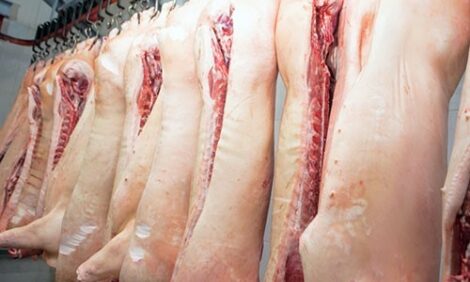



HERNING CONGRESS: Danish Declaration to Increase Slaughter Pig Production
DENMARK - An agreement has been signed in Herning Denmark this week between pig producers, slaughterhouses and the food industry to boost slaughter pig production and cut exports of piglets to Germany, writes Chris Harris from Herning.The Herning Declaration signed at the start of the pig industry congress will seek to increase production of slaughter pigs in Denmark by two million over the next two years.
The agreement aims to make pig production in Denmark more efficient and to reduce risk to the Danish pig producers.
In recent years, the Danish slaughter industry has seen several obsolete slaughterhouses close and capacity moved to more efficient and newer plants.
Danish Crown's showpiece slaughterhouse in Horsens, which was initially built to have a capacity of about 75,000 pigs a week, is now slaughtering 100,000.
According to Asger Krogsgaard, chairman of the Svinslagteriforum, DAFC (SSF) (pictured) the slaughterlines have speeded up and the capacity of the slaughterhouses has not been reduced and the industry is now better equipped to deal with the slack periods over holidays and during the summer.
The slaughterhouses have also agreed new piece-work rates for the slaughtermen that have reduced costs for the pig producer.
However, Mr Krogsgaard said that the industry needs to build up its slaughter pig capacity and the unique agreement reached at the Herning congress between the slaughterhouses and the pig producers is being backed by the food trade union, NFF.
The agreement looks to see old inefficient pig production facilities closed down and new pig barns build to eventually accommodate two million slaughter pigs.
The agreement will also have social and environmental impact as it will take into account water use, the production and disposal of waste, energy, road taxes and other issues that all have a cost to pig production in Denmark.
Mr Krogsgaard said the agreement will also help to cut risk because it will see the pig producers invest in farms in both new buildings and land.
He added that the pig producers in Denmark are also more able to minimise risk because about 70 per cent of the feed grain on the farm is grown on the pig producing farms.
This is limiting the cost of production for the producer, Mr Krogsgaard said.
"It is a way to secure risk on the farm" Mr Krogsgaard said.
"For four or five years, prices of feed went up dramatically and then we have had the financial crisis.
"It has been a hard period to come through.
"We could not get money to develop the farms but we saw piglets being sold into Germany going into the EU market and attracting good prices."
However, Mr Krogsgaard said that the German piglet market was very volatile and by rebuilding the slaughter pig sector in Denmark, much of this volatility will be smoothed out.
He said that as prices go up and down in the piglet market, the farmers will need more piglets capacity to cope with it.
The pig producers are now hoping to persuade the Danish government to back the scheme and to produce a level playing field for producers compared to those in Germany, who, he says, receive indirect support through schemes to aid solar cell installation on farms and the development of new biogas plants.
The increase in production capacity of slaughter pigs in Denmark and the development of new pig barns and improved facilities is estimated will cost DKK1.6 billion.
In the Herning Declaration, the producers and slaughterhouses are asking the government to support loans for the development of farms by acting as a guarantor.
Nicolaj Norgaard, director of the Danish Pig Research Centre said: "We were exporting weaner pigs in the early 2000s because it was the most economic way to invest in the workforce.
"Now we are trying to get more slaughter pigs bred and raised in Denmark rather than exporting them."
He added: "We are willing to invest if we can get the money and we need the government to ensure the right environment.
"We need the government to guarantee the money for the investment."
Mr Norgaard added that by producing more slaughter pigs, the Danish industry would also be able to increase exports to the lucrative Chinese market, particularly in by-products.
At present, Denmark exports one container of products for the Chinese market every hour, seven days a week.
He said that at present Denmark exports about eight million piglets to Germany worth about DKK2.4 billion to the industry. However, the export of products to China is expected to match this figure and the increase in slaughter pigs will help boost this trade.








